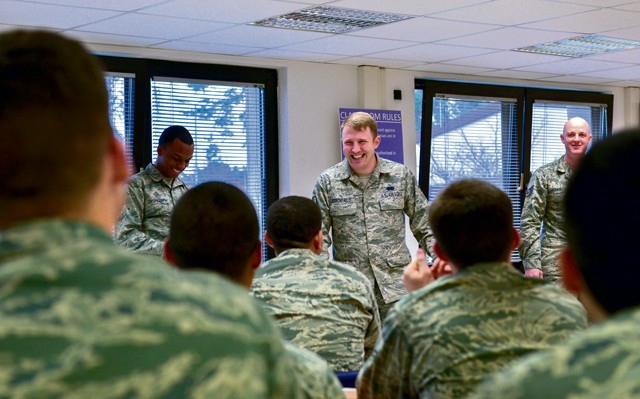
When entering their first base, Airmen need help not only to navigate the base but also the Air Force in general. Thankfully, the First Term Airman’s Center is there to educate and start them on the right path.
FTAC prepares Airmen for challenges they will face in the operational Air Force. The time spent with the FTAC is a way for Airmen to transition from a training environment to the operational military life.
Senior Master Sgt. Robert Berrier, 86th Force Support Squadron career assistance advisor, is one of two personnel of the FTAC operations at Ramstein. According to Berrier, the program makes Airmen more responsible and knowledgeable, and it’s largely due to the leads.
“Our FTAC leads have such a huge responsibility in setting the tone for our Airmen,” Berrier said. “Week in and week out, they make it happen. They help enable Airmen to be both mission-focused and ready when they return to their duty sections.”
Senior Airman John Burchfield, 86th FSS FTAC lead, believes his job as an instructor involves more than just teaching others, but being taught himself and holding a sense of pride for the Airmen he serves.
“I didn’t realize beforehand how much I would learn from each individual class of Airmen,” Burchfield said. “Spending a week with them and watching them grow and network creates a unique feeling of pride I’ve never experienced.”
The role of an FTAC instructor is about more than teaching Airmen how the Air Force works. According to Burchfield, he learned early how to serve as a role model from his own FTAC leads when he entered the operational Air Force and arrived at his first duty station.
“I remember my FTAC lead and how awesome and motivated she was,” Burchfield said.
Remembering his FTAC instructor pushes him to rekindle Airmen’s motivation in serving. The Airmen he teaches could become outstanding, and that amazes him, he says.
“When the Airmen leave after the course is over, I am blown away from just imagining how far some of them will go. It’s amazing to know I’ve made an impact on their lives.”
Every week, the FTAC continues to take in new Airmen and sends them out of the course educated with a new insight of how Ramstein functions as well as new Air Force knowledge. Airmen depart with a plethora of knowledge from all the base agencies that visit them during their time in the class such as finance, Airman and Family Readiness and the Honor Guard.
Ramstein FTAC serves more than 750 Airmen every year and strives to get the best instructors looking to make a difference during their four-month assignment. For more information about the FTAC or how to become an instructor, contact the FTAC at 480-9472 or Ramstein.caa@us.af.mil.







